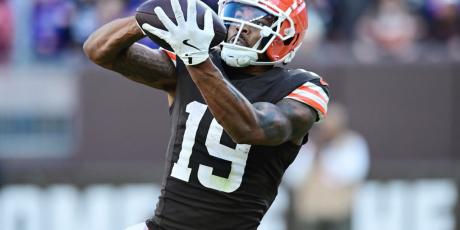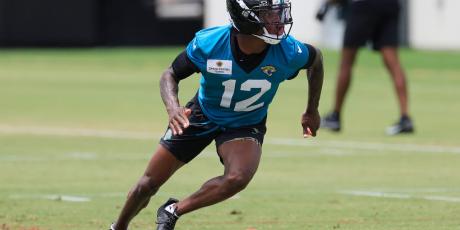Is Rob Gronkowski Worth a First Round Pick in MFL10s?

When drafting tight ends in best ball leagues, one of the biggest decisions can be whether or not it's worth it to pay a first round price for Rob Gronkowski. One aspect of that decision making process is analyzing how Gronk paired with a late round tight end compares to other typical tight end combinations. This study will do just that, by exploring how common tight end pairings fared in 2015. The purpose of this study is simply to compare common best ball tight end duos and does not consider things like the opportunity cost of drafting a tight end in the first round or three tight end draft strategy.
The Methodology
Using full season 2015 MFL10 ADP, and assuming typical best ball tight end drafting strategy, I sorted tight ends into the following groups:
- Rob Gronkowski & very late round TE (positional ADP 24-27)
- TE ADP 2-4 & TE ADP 21-23
- TE ADP 5-7 & TE ADP 18-20
- TE ADP 8-10 & TE ADP 15-17
- Two TEs with positional ADP 11-14
For each group, I examined all possible TE combinations and calculated the best-case and worst-case scenario scoring pairs, as well as the average optimal score of each group. I then took all scoring scenarios and compared each group to the Gronk group to see which pairings yielded the most best ball points, and in turn, if it’s worth it, simply from an end of season tight end scoring perspective, to invest in Rob Gronkowski in the first round.
The Best of the Bunch
Of every possible tight end pairing in 2015, the best possible best ball combination was Jordan Reed (ADP TE22) and Greg Olsen (TE3), yielding 324.7 best ball points. Reed was a golden ticket to anyone that drafted him. If we remove Reed from the equation, the top TE pairing was Rob Gronkowski and Richard Rodgers (ADP TE27), a combo that scored 306.1 best ball points. Of course, not every team had exposure to Gronk or Reed, so here’s a look at the rest of the typical 2015 tight end combos.
2015 Best Ball Scoring Scenarios for Typical Tight End Pairings
| Best Ball Points | |
|---|---|
| Group Average | 277.3 |
| Best- Case Scenario (Gronk / Richard Rodgers) | 306.1 |
| Worst-Case Scenario (Gronk / Heath Miller) | 252.9 |
If you drafted Gronk and waited until the very end to take your second tight end, the worst-case scenario was a pairing with Heath Miller. The Gronk/Miller combo produced 252.9 points, but Miller contributed just 1.1 points all season!
| Best Ball Points | +/- vs Typical Gronk Pair | |
|---|---|---|
| Group Average | 239.8 | -37.5 |
| Best- Case Scenario (Greg Olsen Olsen / Jordan Reed) | 324.7 | 18.6 |
| Worst-Case Scenario (Jimmy Graham / Coby Fleener) | 162.2 | -90.7 |
Besides the Jimmy Graham/Coby Fleener combination, this group performed quite strong overall. Compared to the average production of the groups that we’ll look at shortly, even the Graham/Fleener combo fared relatively well. Although Graham disappointed, finishing as the TE16 on the season, Travis Kelce and Greg Olsen paid back their investments nicely, finishing as the TE6 and TE3, respectively.
As mentioned before, Jordan Reed gave a huge boost to this group’s average best ball score. Even if we remove Reed, the optimal TE combo from this group (Greg Olsen and Ladarius Green) outperformed any other non-Gronk pairing.
| Best Ball Points | +/- vs Typical Gronk Pair | |
|---|---|---|
| Group Average | 150.6 | -126.7 |
| Best- Case Scenario (Julius Thomas / Eric Ebron) | 195.3 | -110.8 |
| Worst-Case Scenario (Jordan Cameron / Vernon Davis) | 109.9 | -143 |
The mid-range TE1 group paired with the lower end TE2 performed worse than any other group, producing the lowest average optimal score and the lowest scoring best-case scenario.
Values vary from year to year, but in 2015 investing in semi-expensive tight ends turned out to be a disappointment, despite the name value of players like Martellus Bennett and Julius Thomas, and to a lesser extent Jordan Cameron.
| Best Ball Points | +/- vs Typical Gronk Pair | |
|---|---|---|
| Group Average | 194.7 | -82.6 |
| Best- Case Scenario (Tyler Eifert / Antonio Gates) | 229.4 | -76.7 |
| Worst-Case Scenario (Jason Witten / Josh Hill) | 154.3 | -98.6 |
Pairing a low end TE1 with a higher end TE2 proved to be one of the lowest variance drafting strategies in 2015. Though this group’s ceiling was the second lowest of any group, their floor was only eight points off the pace of the second best group.
Zach Ertz, Jason Witten, and Tyler Eifert all finished as top 10 tight ends. Josh Hill (finished as TE47) was the only disappointment of the TE2 group, while Antonio Gates finished as the TE12 and Owen Daniels ranked 21st among tight ends at season’s end.
| Best Ball Points | +/- vs Typical Gronk Pair | |
|---|---|---|
| Group Average | 180.7 | -96.6 |
| Best- Case Scenario (Delanie Walker / Kyle Rudolph) | 242.8 | -63.3 |
| Worst-Case Scenario (Austin Seferian-Jenkins / Dwayne Allen) | 88.4 | -164.5 |
Since this group wasn’t anchored by a top-tier tight end, it’s probably not surprising that pairing two fringe TE1s resulted in a very wide range of outcomes. Delanie Walker, who finished as the TE5, really carried the group. If you implemented this draft strategy and missed on Walker, there was little chance of success. Austin Seferian-Jenkins and Dwayne Allen both had disappointing, injury-plagued season, resulting in the worst optimal score of any pair in any group, yielding just 88.4 best ball points.
Conclusion
Unless you score a lottery ticket like Jordan Reed, which can be nearly impossible to pinpoint, it’s no surprise that rostering Gronk results in the most tight end points, even in a best ball format. What is a bit of a surprise is how much scoring dropped off in 2015 from the top-tier TE1 group to the mid-tier TE1 group. If we remove Jordan Reed, the drop off in best-case scenario from the Gronk group to the high-end TE1 group was only 30 best ball points. The drop off in the worst-case scenario between the two groups, though, was 90 best ball points. Tight end seems much deeper in 2016, and should result in a much more gradual decrease in scoring across all tight end tiers.
As 2015 showed, even if the second tight end in a Gronk pair only contributes 1 point, Gronk scores so consistently that he can carry your tight end group and can possibly win your league. If you pair Gronk with a late second tight end that produces like a Richard Rodgers from 2015, then you can dominate the tight end slot, and at the very least have a reliable insurance policy if Gronk goes down.
When considering whether or not to spend first round capital on Gronk, weigh the upside vs other first round players as well as how much you trust other late round tight ends. If you believe, like I do, that tight end is stronger in 2016, then maybe you ignore these results and go back to a cheaper tight end strategy. On the other hand, since tight end is inherently volatile, and Gronk is clearly the leader of the pack, maybe you trust last year's numbers and lock in that tight end scoring on your roster.
Because Gronk is such an expensive investment, buying him is inherently risky, and I will only be taking him sparingly towards the end of the first round.
See you on the Gronk party bus!
Editor's Note: Early bird rates for 4for4's Premium and DFS Subscriptions are available now here.




















